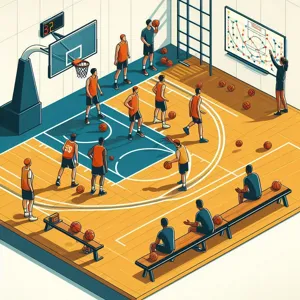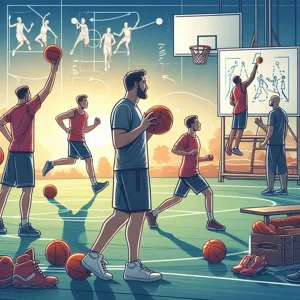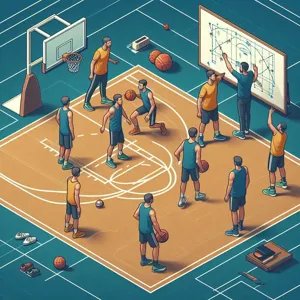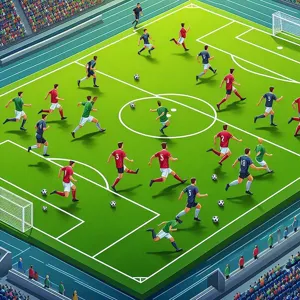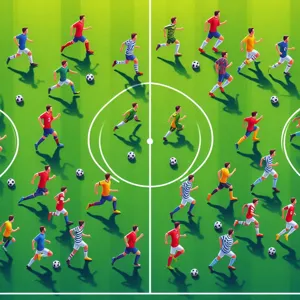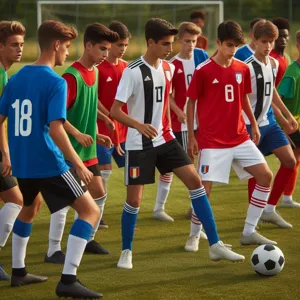Rebounding is often the unsung hero of basketball, yet it’s a crucial skill that can turn the tide of a game.
While dazzling jump shots and fast breaks capture the spotlight, the ability to secure those vital boards can be the difference between victory and defeat. Whether you’re a seasoned player looking to refine your technique or a beginner eager to make your mark on the court, mastering the art of rebounding requires more than just height; it demands strategy, anticipation, and relentless determination. In this comprehensive guide, we will explore proven strategies designed to enhance your rebounding skills, from understanding positioning and timing to developing a tenacious mindset. Get ready to elevate your game and become a rebounding powerhouse that can command the paint and lead your team to success!
1. Introduction to Rebounding in Basketball

Rebounding is often the unsung hero of basketball; while flashy dunks and three-point shots steal the spotlight, it’s the solid, gritty work on the boards that can truly make or break a game. In essence, rebounding is the art of reclaiming possession after a missed shot, a skill that requires a unique blend of tenacity, positioning, and timing. It’s not just about height; it’s about heart, hustle, and a relentless drive to seize the moment.
In every game, the battle for rebounds begins the moment a shot goes up. Players must anticipate the trajectory of the ball, often predicting where it will land based on the shooter’s angle and distance. This involves not just physical attributes but also a keen understanding of the game and a readiness to outmaneuver opponents. Whether you’re an aspiring player or a seasoned veteran, mastering rebounding can provide your team with crucial second-chance opportunities, prevent the opponent from scoring, and ultimately swing the momentum in your favor.
Throughout this guide, we will delve into the fundamental principles of effective rebounding, from footwork and boxing out techniques to mental strategies and drills that can sharpen your skills. By the end of this exploration, you will understand how to make rebounding a cornerstone of your game, transforming you into an indispensable asset on the court. So lace up your sneakers and get ready to dive into the world of rebounding, where every possession counts and determination leads to victory!
2. Understanding the Importance of Rebounding
Rebounding is often regarded as one of the most crucial yet overlooked aspects of basketball. While flashy three-pointers and dazzling layups frequently steal the spotlight, the power of a well-timed rebound can be the game-changer that elevates a team’s performance. Understanding the importance of rebounding goes beyond merely collecting the ball; it’s about seizing opportunities, gaining possession, and creating momentum.
At its core, rebounding embodies the spirit of hustle and determination. It requires players to be in the right position, anticipate missed shots, and engage in physical battles with opponents under the basket. A strong rebounder not only secures the ball for their team but also disrupts the flow of the opposing offense, denying them second-chance points. This defensive prowess can shift the momentum in favor of your team, igniting energy and confidence that can carry through the rest of the game.
Moreover, effective rebounding is vital for transitioning into offense. Once you’ve secured the board, you have the chance to initiate fast breaks, catching the opposition off guard and creating scoring opportunities before they can set up their defense. This ability to control both ends of the court is invaluable and can be the differentiator in closely contested games.
In addition to enhancing team dynamics, mastering rebounding can also bolster a player’s individual reputation. Coaches and scouts often look for players who excel in this area, recognizing that they possess a blend of skill, instinct, and tenacity that can benefit any team. By prioritizing rebounding in your training, you’re not just developing a skill; you’re committing to a mindset that values hard work and team success.
In the following sections, we will delve deeper into specific techniques and drills to refine your rebounding skills, ensuring that you become a vital asset on the court. Remember, every rebound tells a story of effort and determination—make yours a saga of success.
3. Types of Rebounds: Offensive vs. Defensive

Understanding the two main types of rebounds—offensive and defensive—is crucial for any player looking to elevate their rebounding game. Each type requires a distinct mindset, strategy, and set of skills, making it essential to master both for a well-rounded approach on the court.
**Offensive Rebounds** occur when a player retrieves the ball after a missed shot by their own team. This is a critical aspect of maintaining possession and creating additional scoring opportunities. To excel at offensive rebounding, players must anticipate where the ball will go after a missed shot and position themselves accordingly. This often involves boxing out defenders, timing jumps perfectly, and having a nose for the ball. being aggressive and persistent is key; an offensive rebound can lead to a second-chance point, which can be the difference in a close game.
On the other hand, **Defensive Rebounds** happen when a player secures the ball after an opponent’s missed shot. This type of rebound is vital for stopping the opposing team from scoring, and it often initiates a fast break or transition play. Successful defensive rebounding hinges on positioning and physicality. Players must be vigilant about boxing out their opponents, using their bodies to create space, and securing the ball with two hands as it comes down. Defensive rebounds not only prevent second-chance points but also provide an opportunity to reset and strategize for the next offensive play.
By honing skills specific to both offensive and defensive rebounding, players can significantly impact the game, controlling the flow and creating scoring opportunities. Understanding the nuances of each type of rebound prepares players to react quickly, whether they are fighting for an offensive board or securing a defensive stop. Master these fundamentals, and you’ll find yourself not just a participant in the game, but a pivotal force in your team’s performance.
4. Key Physical Attributes for Effective Rebounding
When it comes to rebounding in basketball, honing your skills isn’t just about technique; it’s also about understanding and developing the key physical attributes that can enhance your performance on the boards.
**Strength** is paramount. A strong lower body allows you to establish a solid base, enabling you to box out opponents effectively. Focus on building leg strength through squats, lunges, and plyometric exercises, which will give you the power needed to leap higher and hold your ground against bigger players.
**Vertical leap** is another crucial factor. The ability to jump higher than your opponents can be the difference between securing a rebound and watching it slip away. Incorporating jump training into your routine, such as box jumps and jump rope drills, can significantly improve your vertical leap.
**Agility** plays a vital role as well. Being quick on your feet allows you to maneuver around defenders and position yourself for the rebound. Drills that improve lateral movement, such as cone drills and quick feet exercises, can enhance your agility on the court.
Finally, **endurance** cannot be overlooked. Rebounding requires constant movement and effort throughout the game, so building your cardiovascular fitness is essential. Incorporate interval training and endurance exercises into your workouts to maintain high energy levels during those critical game moments.
By focusing on these key physical attributes—strength, vertical leap, agility, and endurance—you can significantly enhance your rebounding skills. Remember, rebounding isn’t just about height; it’s about tenacity and the ability to outwork your opponents. With dedication and the right training, you’ll become a formidable force on the boards.
5. Developing a Rebounding Mindset

Developing a rebounding mindset is crucial for any player who aspires to dominate the boards. It goes beyond mere physicality; it’s about cultivating a mental approach that prioritizes positioning, anticipation, and relentless effort. To become a great rebounder, you must first understand that every missed shot is an opportunity—an opportunity that you can seize with the right mindset.
Visualize the trajectory of the ball. Watch how it leaves the shooter’s hands, and be prepared for its unpredictable path. Great rebounders are like hawks, keenly observing the game dynamics, anticipating where the ball will land, and positioning themselves accordingly. This requires not only sharp focus but also a deep understanding of the angles and the tendencies of both your teammates and opponents.
Additionally, cultivating an aggressive attitude is vital. Rebounding is often a battle of wills; it’s about being fearless in the paint and not shying away from contact. This means you should be prepared to fight for every board, regardless of your size. Develop a sense of urgency—when a shot goes up, view it as a call to action. Sprint into position, box out your opponent, and use your body as a shield.
Lastly, embrace a growth mindset. Recognize that rebounding is a skill that can be honed through practice and perseverance. Analyze your performances, seek feedback, and remain open to improving your technique. By adopting this rebounding mindset, you’ll not only enhance your own game but also become a pivotal asset to your team’s success on the court.
6. Positioning and Anticipation Techniques
When it comes to rebounding in basketball, positioning and anticipation are paramount. A great rebounder isn’t just stronger or taller than their opponents; they possess a keen sense of where the ball will land and how to get there first. To master this vital aspect of the game, you need to develop a combination of awareness, timing, and strategic placement.
First and foremost, understanding the trajectory of a shot is crucial. Players who can read the player’s shooting form and the angle of the shot will have a significant advantage. For instance, when a player takes a shot from the perimeter, the ball will likely come off the rim at a different angle than if they were shooting from close range. By studying these patterns, you can position yourself accordingly, anticipating whether the ball will bounce toward the baseline or the top of the key.
Once you’ve established your positioning, maintaining a low center of gravity is essential. When you’re closer to the basket, squat down slightly and keep your feet shoulder-width apart. This stance not only gives you stability but also allows for quick lateral movements. As the shot goes up, use your body to shield your opponent from getting to the ball. The key is to establish a physical presence without committing a foul.
Anticipation also involves reading your opponents. Be aware of their movements and positioning. If you notice a player consistently leaning toward the basket when a shot goes up, you can counteract this by moving in the opposite direction to position yourself for the rebound. Always be prepared to react quickly; a split second can make the difference between securing the rebound and losing it to an opponent.
Lastly, practice makes perfect. Simulate game scenarios during training where teammates take different types of shots, and work on your positioning and reaction time. The more you familiarize yourself with various shooting angles and player behaviors, the better your anticipation will become. By honing these skills, you’ll not only improve your rebounding game but also significantly contribute to your team’s overall success on the court.
7. The Art of Boxing Out: Step-by-Step Guide

When it comes to rebounding in basketball, mastering the art of boxing out is essential. This fundamental skill can significantly increase your chances of securing the ball after a missed shot. Boxing out is not just about physical strength; it’s about positioning, timing, and smart anticipation. Here’s a step-by-step guide to help you perfect this crucial technique:
**1. Anticipate the Shot:** The moment the ball leaves the shooter’s hands, begin your preparation. Keep your eyes on the ball while also being aware of your opponents’ positions. Understanding the shooter’s tendencies can give you an edge in predicting where the ball might land.
**2. Establish Your Position:** As soon as you sense a shot is imminent, move toward the player you’re responsible for guarding. Get low and create a solid base with your feet shoulder-width apart. This stance will provide you with stability and balance.
**3. Make Contact:** Use your body to make contact with your opponent. Position yourself between them and the basket, using your hips and lower body to create a barrier. It’s crucial to initiate this contact without reaching or pushing—use your body’s mass to your advantage.
**4. Widen Your Base:** Once you’ve made contact, widen your stance further. This will give you the leverage you need to hold your ground against any attempts from your opponent to push through or get around you.
**5. Keep Your Eyes on the Ball:** As the ball arcs toward the rim, maintain your focus on it while also keeping one eye on your opponent. This dual focus will help you react quickly, whether you need to secure the rebound or defend against a potential move.
**6. Use Your Arms:** Extend your arms outwards to create space and prevent your opponent from slipping past you. Keep your elbows wide and ready to make a grab for the ball. If you’re positioned correctly, your opponent will find it difficult to reach around you.
**7. Time Your Jump:** When the ball is close to the rim, use your legs to spring into action. Timing is key—wait until the ball is at its peak before leaping. This will maximize your height and give you the best chance of snatching the rebound.
**8. Secure the Ball:** Once you’ve caught the ball, bring it down securely to your chest and protect it from defenders. Utilize your body as a shield, turning away from traffic to ensure you maintain possession.
**9. Transition Quickly:** After securing the rebound, look for your next move. Whether it’s initiating a fast break, passing to a teammate, or resetting the offense, a quick transition can turn a defensive play into an offensive opportunity.
By incorporating these steps into your practice routine, you’ll not only enhance your boxing out technique but also become a more formidable presence on the boards. Remember, rebounding is a blend of skill and tenacity, and mastering the art of boxing out is key to becoming a rebounding powerhouse on the court.
8. Timing Your Jump for Maximum Effect
Mastering the timing of your jump can be the difference between snatching a rebound and watching the ball slip through your fingers. In basketball, rebounding is as much about anticipation as it is about athleticism. To truly enhance your rebounding skills, you must develop a keen sense of timing that allows you to leap at just the right moment.
The key to timing your jump lies in your ability to read the trajectory of the ball. As a shot goes up, watch not just the shooter but also the angle at which the ball is released. This will give you critical insights into where it’s likely to land. Practice reading the arc of different types of shots—whether it’s a three-pointer or a layup—as they can vary significantly.
Once you’ve identified where the ball is likely to fall, position yourself accordingly, using your body to box out opponents and secure a prime spot under the basket. Remember, it’s not just about being the first to jump; it’s about jumping at the peak of your opponent’s jump. This requires a combination of body control and instinct—learn to recognize when to hold back and when to spring into action.
Drills can be highly beneficial in honing your timing. Practice jumping drills that simulate game situations, focusing on your reaction time and the ability to quickly gauge the ball’s path. Incorporate plyometric exercises to build explosive leg strength, enabling you to leap higher and more effectively when the moment arises.
Ultimately, mastering the timing of your jump will not only improve your rebounding stats but will also elevate your overall game. When you consistently time your jumps correctly, you’ll become a formidable presence on the boards, turning missed shots into opportunities for your team and asserting your dominance in the paint.
9. Practicing Rebounding Drills
Practicing rebounding drills is essential for developing the skills needed to dominate the boards during a game. Rebounding is not just about height; it’s about timing, positioning, and tenacity. Incorporating a variety of targeted drills into your training routine can significantly enhance your rebounding prowess, making you a formidable force on the court.
One effective drill is the **Box Out Drill**, where players pair up—one as the shooter and the other as the rebounder. The shooter takes a shot while the rebounder must establish position, using their body to block the opponent and secure the rebound. This drill hones your ability to anticipate the trajectory of the ball and reinforces the importance of physicality in rebounding.
Another excellent drill is the **Rebound and Outlet Drill**. In this exercise, players practice gathering rebounds and immediately transitioning into an outlet pass. This not only builds your rebounding skills but also emphasizes the importance of quickly moving the ball up the court after a rebound, fostering a fast-paced offensive approach.
To improve your timing and jumping ability, incorporate **Jumping Drills** into your routine. Exercises such as box jumps or plyometric drills can enhance your vertical leap, giving you the extra inches needed to snag those high rebounds. Combine these with **Footwork Drills**, like lateral shuffles and closeout techniques, to develop the quickness and agility necessary for effective rebounding in dynamic game situations.
Finally, consider adding **conditioning Drills** focused on stamina and endurance. A strong rebounding game requires not just skill but also the physical fitness to maintain that intensity throughout the game. Incorporating sprints, shuttle runs, or interval training into your practice will ensure you remain a relentless force on the boards, no matter how the game unfolds.
By diligently practicing these rebounding drills, you’ll not only improve your individual skills but also become a key player in your team’s overall performance. Rebounding isn’t just an individual effort; it’s about outworking your opponents and creating opportunities for your team. So lace up your sneakers and get ready to elevate your game!
10. Utilizing Video Analysis for Skill Improvement
In the modern age of sports training, video analysis has emerged as a powerful tool for athletes looking to improve their skills, and rebounding is no exception. By capturing your gameplay on video, you can gain invaluable insights into your positioning, timing, and overall technique. This method allows you to see yourself in action, providing a perspective that is often difficult to grasp in the heat of the moment.
Start by recording both practice sessions and actual games. Pay close attention to key moments when you are in rebounding situations. How do you position yourself relative to other players? Are you anticipating missed shots effectively? Are you boxing out properly? Watching these clips can reveal patterns in your movements and decisions that need addressing.
Once you’ve gathered some footage, analyze it critically. Look for areas where you can improve—maybe you’re not as aggressive as you could be in securing the board, or perhaps you’re not utilizing your body effectively to shield opponents. Consider comparing your footage with that of professional players who excel in rebounding. Observe their footwork, approach angles, and how they leverage their bodies to gain an advantage.
Incorporating video analysis into your training regimen not only helps you identify weaknesses but also allows you to track your progress over time. Set specific goals based on what you observe, and don’t hesitate to share your videos with coaches or peers for feedback. With consistent analysis and targeted practice, you’ll be well on your way to enhancing your rebounding skills and becoming a more formidable presence on the court.
11. Strength and Conditioning for Better Rebounding
To dominate the boards, strength and conditioning are non-negotiable components of your training regimen. Rebounding isn’t just about timing and positioning; it also requires the physical prowess to outmuscle opponents and maintain your balance amidst the chaos of the paint. A well-rounded strength training program can significantly enhance your ability to secure those coveted rebounds.
Focus on building core strength, as a stable core is crucial for maintaining control while jumping and boxing out. Incorporate exercises like planks, medicine ball twists, and rotational movements that mimic the dynamics of rebounding. Leg strength is equally vital; squats, lunges, and deadlifts will help you develop explosive power in your legs, allowing you to leap higher and push through the crowd of players.
Don’t overlook the importance of conditioning. Basketball is an intense sport that demands not just strength, but also endurance. Implement high-intensity interval training (HIIT) and agility drills to increase your stamina and speed on the court. By improving your overall fitness, you’ll be able to maintain your energy levels throughout the game, giving you the edge in those crucial moments when it comes to snatching the rebound.
Lastly, incorporate plyometric exercises such as box jumps and jump squats into your routine. These exercises will enhance your explosive jumping ability, making it easier to reach that ball when it’s at its highest point. Remember, rebounding is a skill that combines physical attributes with technique, and by focusing on strength and conditioning, you’re setting yourself up for success on the boards. As you develop your body, you’ll find that your confidence grows, and with it, your ability to control the paint and make a significant impact on the game.
12. Learning from the Pros: Rebounding Legends
When it comes to mastering the art of rebounding in basketball, there’s no better way to elevate your game than by learning from the legends who have dominated the boards throughout history. These players not only excelled at securing rebounds but also transformed their techniques into an art form, setting benchmarks for aspiring athletes.
Take, for instance, Dennis Rodman, a player often hailed as one of the greatest rebounders of all time. Rodman’s uncanny ability to anticipate where the ball would land allowed him to position himself perfectly for both offensive and defensive boards. His relentless hustle and tenacity on the court serve as a reminder that rebounding is as much about desire and effort as it is about skill. Studying his footwork, positioning, and timing can provide invaluable insights into how to improve your own rebounding abilities.
Another towering figure in rebounding is Wilt Chamberlain, who, with his remarkable height and athleticism, redefined the role of a big man in basketball. Wilt’s approach combined strength with finesse, showcasing the importance of boxing out opponents and using your body to create space. Observing Chamberlain’s games reveals the necessity of using your body effectively and understanding angles when contesting for a rebound.
To truly grasp the nuances of rebounding, consider the techniques of modern legends like Dwight Howard or DeAndre Jordan, who blend raw athleticism with strategic positioning. Watching their games will help you understand how to leverage your size and speed, as well as how to read the trajectory of missed shots to get an edge on your competition.
By studying these rebounding legends, you can cultivate a better understanding of the mental and physical aspects of this crucial skill. Analyze their movements, learn their techniques, and incorporate their strategies into your training. Whether you’re watching game footage or practicing on the court, understanding how these pros approached rebounding can inspire you to elevate your own game and become a force on the boards. After all, great rebounding is not just about height; it’s about heart, hustle, and a relentless pursuit of the ball.
13. Common Mistakes to Avoid in Rebounding
Rebounding is a crucial aspect of basketball that can often be the difference between winning and losing a game. However, many players fall into common pitfalls that hinder their ability to effectively secure the ball off the rim. Understanding these mistakes and learning how to avoid them can significantly enhance your rebounding skills.
One of the most prevalent errors is neglecting to box out your opponent. Many players get caught up in the excitement of the game and forget to establish a physical presence against their rivals. Failing to box out allows opposing players to slip past you for easy rebounds. Always make it a priority to position your body between the basket and your opponent, using your hips and legs to create a sturdy barrier.
Another mistake is not anticipating the trajectory of the ball. Players often watch the shot instead of predicting where it will land. Familiarize yourself with the shooter’s tendencies and the angle of their shot to improve your ability to read the bounce off the rim. This foresight can give you a significant edge in positioning yourself for a successful rebound.
Additionally, many players underestimate the importance of timing. Jumping too early can leave you out of position when the ball finally comes down. Conversely, waiting too long can mean missing the chance altogether. Practice your timing by watching the ball and the shooter, syncing your jump with the moment the ball touches the rim.
Lastly, physical conditioning plays a pivotal role in rebounding. Fatigue can impair your ability to box out, jump, and maintain focus. Ensure that you are in peak physical condition to outlast your opponents in those crucial late-game moments.
By being aware of these common mistakes and consciously working to avoid them, you can elevate your rebounding game and become a key player on the court. Remember, effective rebounding is about discipline, anticipation, and effort—master these elements, and you’ll dominate the boards.
14. Incorporating Rebounding into Team Strategies
Incorporating rebounding into your team strategies is essential for building a well-rounded and competitive basketball squad. Rebounding is not merely an individual skill; it’s a collective effort that can significantly influence the outcome of a game. To master this aspect, teams need to develop a cohesive rebounding philosophy that emphasizes positioning, communication, and anticipation.
Begin by instilling a mindset that prioritizes rebounding in every practice session. Coaches should highlight its importance during drills, encouraging players to view rebounding as a critical phase of both offense and defense. Emphasize the concept of “boxing out”—the technique of positioning oneself between an opposing player and the basket to secure the rebound. Teach players to make contact with their opponents and use their bodies effectively to maintain position.
Incorporate specific rebounding drills into team practices. For example, use small-sided games that reward teams for securing boards or create competitive scenarios where players must race for rebounds after missed shots. These drills not only enhance individual skills but also foster teamwork and awareness on the court.
Communication is key. Encourage players to call out when they have identified a potential rebound opportunity, signaling to teammates to crash the boards or fall back on defense. This collective awareness can make all the difference, especially in high-pressure situations where every possession counts.
Additionally, analyze your opponents’ rebounding tendencies during game prep. Understanding their strengths and weaknesses can inform your strategy, enabling your players to exploit mismatches and anticipate where the ball is likely to go after a missed shot.
Ultimately, by integrating rebounding into your team strategies, you not only strengthen your defensive capabilities but also create more chances for second-chance points on the offensive end. In basketball, possession is power, and mastering the art of rebounding will ensure your team retains that power throughout the game.
15. Conclusion: The Path to Becoming a Rebounding Machine
In conclusion, becoming a rebounding machine in basketball is not merely about height or athleticism; it’s a mindset coupled with the right techniques and relentless practice. The journey to mastering the boards begins with a deep understanding of the fundamentals—positioning, timing, and anticipation. As you’ve explored throughout this post, developing your footwork and spatial awareness plays a crucial role in securing those vital rebounds.
Moreover, embracing a tenacious attitude will set you apart on the court. Rebounding is often a gritty and unglamorous aspect of the game, but it is essential for establishing dominance and creating scoring opportunities. By incorporating the strategies discussed—such as boxing out your opponent, reading the trajectory of the ball, and leveraging your body to shield and protect your space—you’ll not only improve your own game but also elevate your team’s performance.
Remember, consistent practice is key. Spend time honing your skills during drills and scrimmages, and seek feedback from coaches or experienced players. Track your progress, set personal goals, and maintain a positive mindset. With dedication and perseverance, you will transform your rebounding abilities, becoming a formidable presence on the boards and a player that opponents will respect and fear.
So lace up your sneakers, hit the court, and commit to the path of becoming a rebounding machine. Each rebound you snag is a testament to your hard work and determination, bringing you closer to your full potential in the game. Embrace the grind, and soon enough, you’ll be the player everyone relies on to secure those crucial second-chance opportunities. Your journey to rebounding greatness starts now!
In conclusion, mastering the art of rebounding is an essential component of becoming a well-rounded basketball player, and we hope this blog post has equipped you with proven strategies to elevate your game. From honing your positioning and timing to developing your physical strength and mental focus, each step plays a crucial role in your ability to dominate the boards. Remember, consistent practice and a commitment to improvement will set you apart on the court. As you implement these techniques, you’ll not only enhance your rebounding skills but also contribute significantly to your team’s success. So lace up your sneakers, hit the court, and get ready to make your mark as a rebounding powerhouse!


